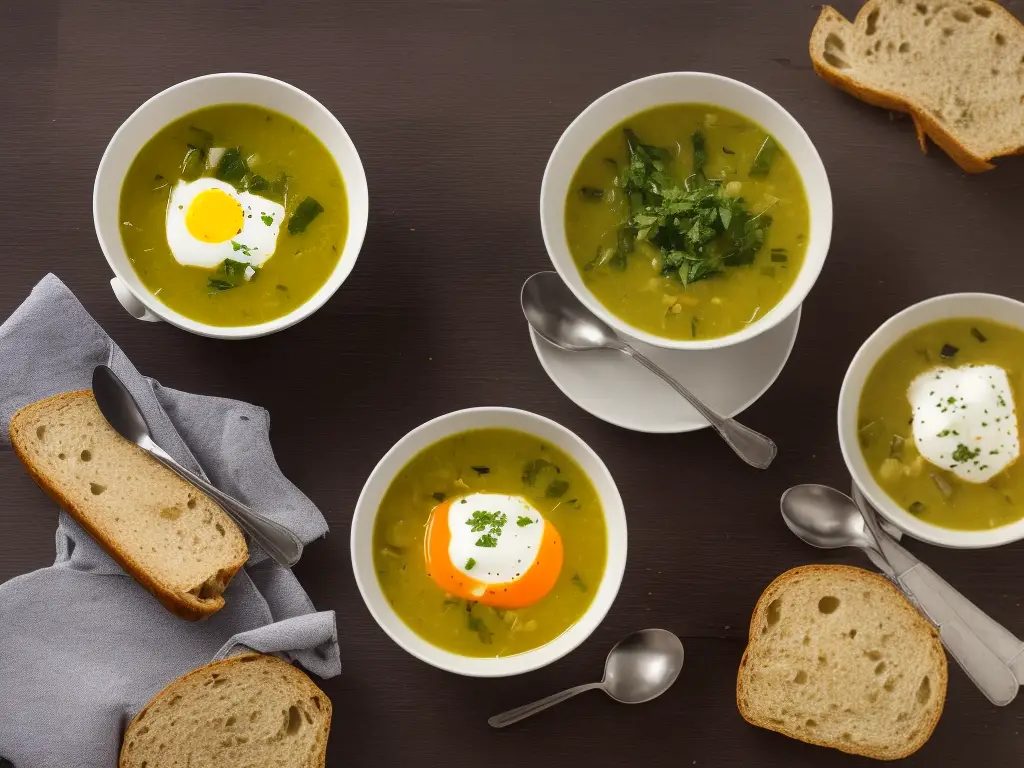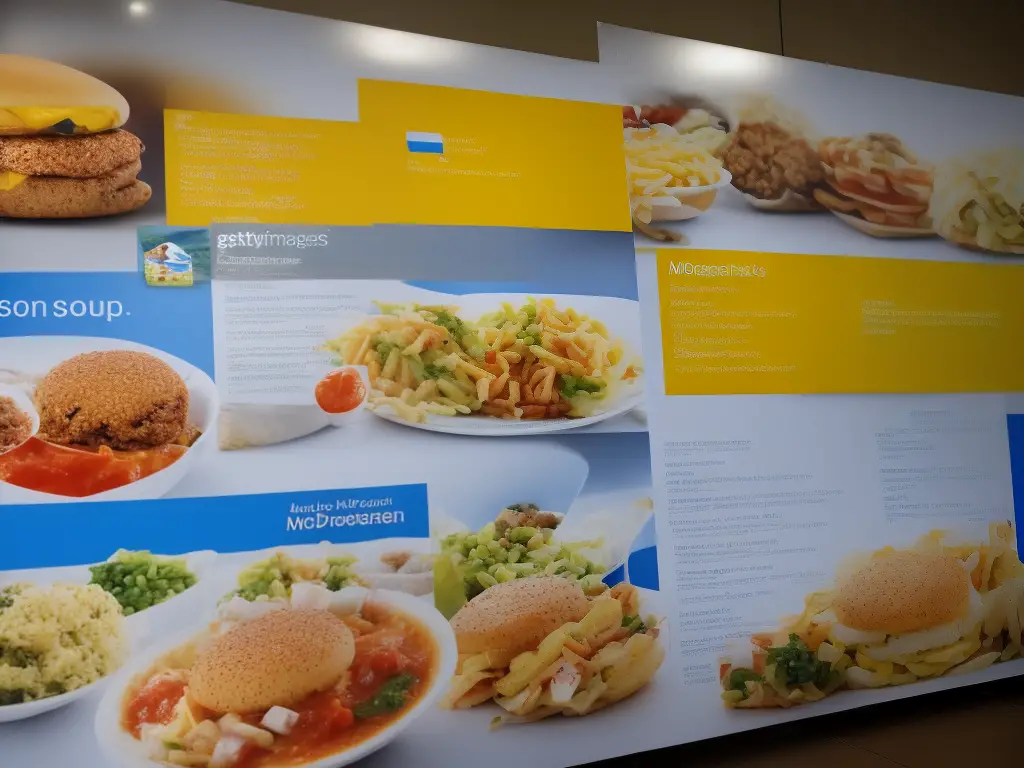McDonald’s, a global giant in the fast-food industry, is known for adapting its menu to cater to local tastes and preferences. In Brazil, one unique offering that has garnered attention is McDonald’s McSoup. This warm and comforting dish has added a new dimension to the Brazilian McDonald’s experience, giving customers a taste of familiar flavors in a distinctive and iconic form. This exploration of McDonald’s McSoup in Brazil delves into its history, varieties, nutrition, consumer perception, market performance, marketing strategies, and future prospects.
History of McDonald’s McSoup
McSoup was introduced in McDonald’s Brazil menu as a seasonal offering during the winter months to cater to the local preferences for warm and hearty meals. Brazil, being a diverse country with varying culinary tastes, led McDonald’s to experiment with different flavors and options to appeal to the local palate. This need to localize the menu and cater to specific tastes became an essential factor in the introduction of McSoup in McDonald’s Brazil.
The initial introduction of McSoup in McDonald’s Brazil can be traced back to the early 2000s, when the fast-food chain sought to expand its menu options in response to the growing competition and changing customer expectations. Around this time, McDonald’s experimented with several other Brazil-specific menu items, including the McCafé line of beverages, and successfully gained traction in the Brazilian fast-food market.
A key factor contributing to McSoup’s successful launch in Brazil was the company’s ability to adapt the product to the regional taste preferences. For instance, McDonald’s Brazil introduced the “Sopas do dia” or “Soup of the day” concept, with a rotating selection of six different soup options, including traditional Brazilian flavors such as Caldo Verde and Canja de Galinha. The soups’ flavor profiles and ingredients suit the local palate, therefore broadening the appeal of the McSoup line.
Another significant aspect of McSoup’s launch in Brazil was the marketing efforts employed by McDonald’s. The fast-food giant utilized extensive promotional campaigns to raise awareness of the new product offering, emphasizing the idea of comfort and warmth during the winter months. By focusing on the benefits of a hot soup during colder weather, McDonald’s was able to position McSoup as a desirable, seasonally-appropriate option for its Brazilian customers.
In recent years, McDonald’s Brazil has continued to innovate and update its McSoup offerings, always considering local food trends and preferences. This dedication to catering to Brazilian tastes has resulted in a variety of delicious soups made with traditional ingredients and flavors. The company has also invested in research and development to improve the quality and consistency of the soups, ensuring they deliver on the brand’s promise of quality and taste. The McSoup’s enduring presence on McDonald’s Brazil menu serves as a testament to the brand’s ability to adapt to local tastes and preferences while maintaining its global appeal.

Varieties of McSoup
One of the most popular McSoup varieties in Brazil is the Caldo Verde, which is a traditional Portuguese soup made with potatoes, kale, and sausage. Incorporating locally-grown and commonly-used vegetables such as onions, garlic, and tomatoes, the soup blends these ingredients with a creamy potato base to create a hearty and satisfying dish that reflects Brazilian culinary culture. This demonstrates how McDonald’s Brazil remains committed to offering menu items that resonate with the local market while still upholding the core values of the global brand.
Another variety of McSoup available in Brazil is the classic Sopa de Legumes, a vegetable soup that combines various vegetables such as carrots, potatoes, and zucchini with a light, flavorful broth. This soup showcases the diversity of vegetables available in Brazil, offering a healthy and comforting option for patrons looking for a lighter meal.
Seasonal and limited-time flavors of McSoup also make regular appearances in McDonald’s locations throughout Brazil. One such limited-time McSoup flavor is Canja de Galinha, a chicken and rice soup traditionally served in Brazilian households as a remedy for colds and flu. This flavorful soup features tender chicken, rice, and vegetables in a soothing broth and provides a comforting taste of home for many Brazilian customers. Another seasonal favorite is the Sopa de Abóbora, a creamy pumpkin soup that is typically served during Brazil’s colder months and includes a mix of pumpkin, carrots, and onions in a savory broth.
In addition to traditional Brazilian flavors, McDonald’s Brazil has also introduced McSoup inspired by international cuisine. For instance, they have offered the Sopa de Lentilha, a lentil soup inspired by Middle Eastern flavors, combining lentils with onions, tomatoes, and a blend of spices such as cumin and turmeric. McDonald’s strives to cater to a diverse range of tastes within the Brazilian market by offering a rotating selection of McSoup flavors.
McDonald’s McSoup in Brazil is a popular and delicious item on the menu, highlighting the diverse flavors found throughout the country. By committing to sourcing local, high-quality ingredients for their McSoup varieties, McDonald’s Brazil ensures that customers can enjoy authentic tastes that reflect the depth and richness of Brazilian cuisine. The use of fresh and locally-grown produce plays a vital role in the creation of delicious McSoup options.

Nutrition and Ingredients
Another key feature of McDonald’s McSoup in Brazil is its low calorie count, making it an appealing option for those who are watching their caloric intake. A serving of McSoup typically contains between 100 and 200 calories, depending on the variety and size. This is significantly lower when compared to other fast food options, such as burgers and fries, which can contain well over 500 calories per serving. This combination of authentic flavors and healthier choices ensures that McDonald’s McSoup remains a popular choice for customers in Brazil.
In terms of main ingredients, McSoup varieties often include different types of vegetables, such as carrots, potatoes, corn, and peas, as well as proteins like chicken or beef. These ingredients provide essential nutrients, such as vitamins and minerals, which are vital to maintaining a healthy diet. For example, carrots are an excellent source of vitamin A, which is important for maintaining good vision and immune system function. Additionally, ingredients like chicken and beef provide protein, which is essential for muscle growth and repair.
As with any food product, it is essential to be aware of any allergens contained in McSoup. The main allergens to consider include gluten and dairy, as many McSoup varieties use wheat-based noodles or contain milk-based ingredients. It’s important to consult with the restaurant staff or review ingredient listings on McDonald’s Brazil website to ensure a specific McSoup variety is safe for individuals with allergies to consume.
While McSoup can be a healthier fast-food option, there can be health concerns associated with its consumption, particularly when it comes to sodium content. Many fast-food products, including soups, contain high levels of sodium as a preservative and flavor enhancer. Excessive sodium intake has been linked to increased blood pressure and an elevated risk of heart disease. Therefore, it’s essential for consumers to be aware of the sodium content in McSoup and keep their daily sodium intake within recommended limits.
Another health-related aspect to consider when consuming McSoup is the potential presence of additives, such as artificial flavors and preservatives. These ingredients can sometimes have negative effects on health, particularly when consumed in large amounts or over an extended period. Although McDonald’s Brazil might follow strict regulations and guidelines when it comes to ingredient sourcing and product manufacturing, it’s crucial for the general public to be well-informed and make conscious choices about their diet to maintain a healthy lifestyle.

Consumer Perception and Reviews
In Brazil, McDonald’s McSoup has garnered a range of consumer reviews, with some appreciating the menu item while others not finding it as satisfying. Introduced to cater to the local Brazilian taste, the McSoup comes in two different variations – McChicken Soup and McChicken Cream Soup. Both versions use the popular chicken recipe and a creamy base to create a delicious soup that would appeal to the Brazilian audience. While many customers perceive the McSoup as an innovative and unique menu offering that adds variety to their fast food experience, keeping in mind the potential presence of additives helps to make informed choices for a healthier diet.
Social media discussions reveal that the McSoup enjoys a mixed response from Brazilian customers. Some users express their satisfaction with the unique taste and creamy texture, finding it a comforting dish tied to their cuisine – a departure from the usual fast-food menu options like burgers and fries. However, others feel that the McSoup does not live up to their expectations, with some even questioning if it belongs in a McDonald’s menu. Such diverging opinions highlight the varied consumer perception of the product.
From an international perspective, McDonald’s McSoup in Brazil has also attracted attention from visitors and online communities discussing unique global McDonald’s menu items. Food bloggers and tourists, intrigued by the variety of soups available, specifically catered for the Brazilian market, often mention them in their reviews and content. These international customers generally appreciate the effort to incorporate region-specific flavors and ingredients in the McSoup and are keen to try the product during their visit to Brazil.
Nonetheless, it is essential to acknowledge that international customers may also have mixed reviews about the McSoup. Some may hold the view that they prefer maintaining the “classic” McDonald’s experience with burgers and fries, while others appreciate the inclusion of local flavors. Furthermore, taste preferences often vary across cultures and nationalities, making the McSoup a potential hit or miss among international consumers.
In summary, McDonald’s McSoup in Brazil has evoked diverse reactions from both domestic and international consumers. Some appreciate the introduction of local flavors into the fast-food menu, while others remain skeptical about its place in a McDonald’s restaurant. The mixed reviews underscore the challenges faced by global chains when adjusting their menu offerings to cater to culturally distinct tastes and preferences. However, McDonald’s McSoup in Brazil ultimately serves as an example of the balancing act between standardization and localization that brands must navigate in today’s global market.

Market Performance and Competition
Despite the mixed reactions, McDonald’s McSoup in Brazil has rapidly become a popular menu option since its introduction. Though specific sales figures and market share numbers for this individual product are not publicly available, it is evident that McDonald’s has maintained a significant position in the Brazilian fast-food market by continuously adding new and innovative items like McSoup to their menu. This strategy targets customer interest and aims to cater to the local tastes and preferences of the Brazilian market.
In terms of competition, McDonald’s Brazil faces several strong opponents in the fast-food industry, including local and international players. Major rivals include Burger King, Subway, and Brazilian chains Giraffas and Habib’s. However, among these competitors, McDonald’s McSoup holds a unique position as it is not a commonly offered item in other fast-food outlets. The introduction of a hot soup item further distinguishes McDonald’s from its competitors, catering to the preferences of Brazilian consumers who enjoy warm comfort food.
Some regional fast-food brands in Brazil have also recognized the consumer demand for soups and have introduced their variations. For example, Giraffas, a popular Brazilian fast-food chain, offers a soup called Sopa no Pão, which is a bread bowl filled with soup. While Giraffas’ soup offerings differ from McDonald’s McSoup in presentation and ingredients, they cater to a similar demographic and customer demand.
Additionally, independent soup-focused restaurants and food kiosks can also be considered indirect competition to McDonald’s McSoup in Brazil. These establishments often offer a wider variety of soup flavors and cater to a more health-conscious and premium market segment. Nonetheless, McDonald’s McSoup remains an attractive option for a more significant number of consumers, thanks to its accessibility, affordability, and the widespread presence of McDonald’s outlets throughout Brazil.
McDonald’s McSoup has managed to maintain a unique position in the Brazilian fast-food market due to its novelty and distinctiveness compared to other fast-food offerings. The introduction of this product has allowed McDonald’s to maintain a significant presence in a rapidly-evolving and competitive environment.

Marketing and Advertising Strategies
By tailoring McSoup specifically for the Brazilian market, McDonald’s has adapted to the unique preferences of consumers in the region. Advertising and marketing efforts for this new menu item have been crucial in raising awareness and increasing sales. As long as McDonald’s continues to hone its product offerings and cater to the unique preferences of Brazilian consumers, the company’s market position is likely to remain strong in the face of competition.
One of the key marketing strategies employed by McDonald’s in Brazil is the localization of their menu, demonstrating a deep understanding of regional tastes and preferences. McSoup reflects this strategy, targeting Brazilian consumers who enjoy traditional soup dishes.
Social media has played an essential role in promoting McSoup in Brazil. McDonald’s Brazil taps into the widespread use of social platforms such as Facebook, Instagram, and Twitter in the country to promote their products. The fast-food giant creates engaging and visually appealing content to showcase McSoup, accompanied by hashtags like #McSoup and #McDonaldsBrasil. Using social media influencers as part of their advertising strategy, McDonald’s collaborates with popular local celebrities and influencers to endorse McSoup and reach a wider audience. This, in turn, boosts the product’s credibility and popularity.
In addition to social media campaigns, McDonald’s in Brazil has also relied on traditional media channels to advertise McSoup. Billboards, television commercials, and radio spots have all been employed to publicize the new menu item. The messaging in these ads often emphasizes the product’s quality, warmth, and comforting nature – qualities that are especially appealing to Brazilian consumers, given the country’s colder regions.
Besides relying on an omnichannel advertising approach, McDonald’s has formed partnerships with local Brazilian brands to boost the visibility of McSoup. These strategic alliances with popular regional brands demonstrate a commitment to local authenticity, reinforcing the notion that McSoup is a product tailored specifically for the Brazilian market. Such partnerships also create a sense of familiarity for consumers, who are more likely to try a new product if it is endorsed by familiar and trusted brands.
Utilizing a mix of online and offline marketing channels, McDonald’s has successfully made McSoup a desirable menu item for customers in Brazil. By employing localized messaging, strategic partnerships, social media influence, and traditional advertising methods, they have managed to strengthen the visibility and appeal of McSoup in Brazil’s competitive fast-food market. These marketing and advertising techniques allow McDonald’s to differentiate themselves from their rivals and attract patrons searching for warm, comforting, and convenient meal alternatives.

Future Prospects and Challenges
With McSoup proving to be a popular choice since its introduction in Brazil, McDonald’s sees potential for further growth and diversification. The promising performance of this menu item may pave the way for expansion and continued innovation in the future.
There is an opportunity for McDonald’s to continue its product line expansion by introducing new flavors and ingredients that cater to local tastes and preferences. These could include utilizing regional flavors and ingredients to create unique, localized soups that are only available in Brazil, increasing the appeal of the product. Moreover, as the health and wellness trend continues to grow globally, McDonald’s could also capitalize on this by offering healthier soup options made from locally sourced, fresh ingredients.
Another area of potential growth for McDonald’s McSoup in Brazil is its increased focus on the delivery and takeaway market. As the world continues to navigate the impacts of the COVID-19 pandemic, more consumers are choosing to order food for delivery or pick-up. McDonald’s Brazil could leverage this trend by offering McSoup as a convenient option for consumers who desire warm, satisfying meals without having to leave their homes. This increased focus on delivery and takeout options could also benefit other areas of McDonald’s Brazil’s menu, further boosting the company’s overall growth.
Challenges for the McDonald’s McSoup in Brazil could arise in maintaining product quality and consistency across different locations. As the product expands, ensuring that the quality of ingredients and taste remains consistent may prove difficult. This challenge could be exacerbated by the varying availability of ingredients in Brazil, which could lead to inconsistency in flavors or textures. Addressing this issue may require McDonald’s Brazil to closely monitor its supply chain and establish strong relationships with local suppliers to ensure the constant availability of high-quality ingredients.
Increased competition from local and international players who are also looking to capitalize on the growing soup market in Brazil is another challenge for the McSoup. To remain competitive, McDonald’s must continue to innovate and differentiate its McSoup offerings from those of its competitors. This can be done by regularly launching new flavors, incorporating seasonal ingredients, or engaging in marketing campaigns that highlight the unique aspects of McDonald’s McSoup options. Additionally, understanding customers’ preferences, tastes, and demands through market research will help McDonald’s stay ahead of the changing trends and tastes of Brazilian consumers.
Lastly, as consumers grow increasingly conscious of the environmental impact of their choices, it is important for McDonald’s Brazil to consider the sustainability of its McSoup offerings. This could involve reviewing the packaging materials used for McSoup, as well as the sourcing of ingredients and waste management. By addressing potential environmental concerns and adopting sustainable practices, McDonald’s Brazil can create a positive image and overall experience for its customers, while contributing to the long-term success of the McSoup product line.

From its inception to its current status, McDonald’s McSoup in Brazil has demonstrated the brand’s ability to adapt to local preferences and expand its offerings beyond its traditional fare. With a variety of flavors catering to Brazilians, attention to nutritional aspects, and targeted marketing, McSoup has carved a niche for itself in the country’s fast-food landscape. As McDonald’s continues to innovate and address potential challenges, the iconic McSoup is poised to remain a popular and endearing part of the Brazilian McDonald’s dining experience.
